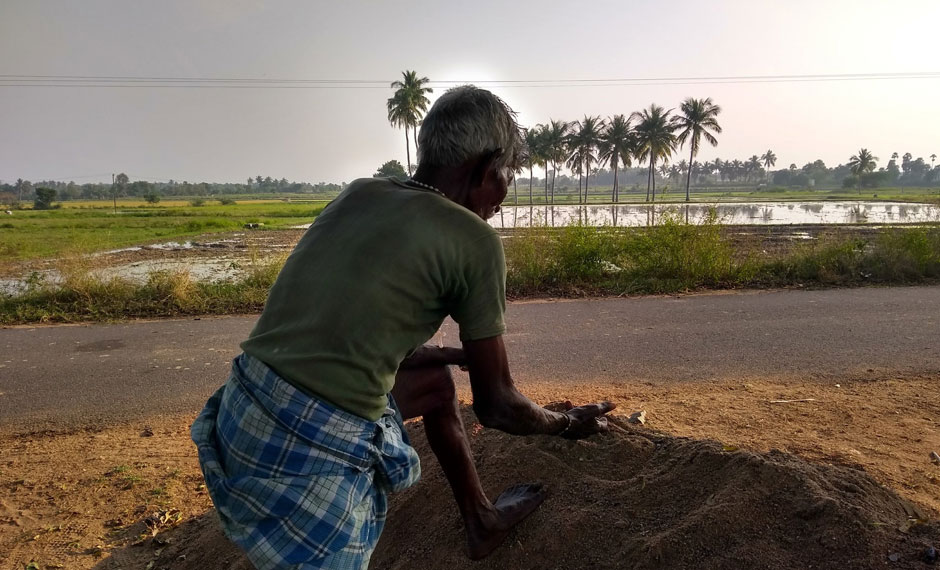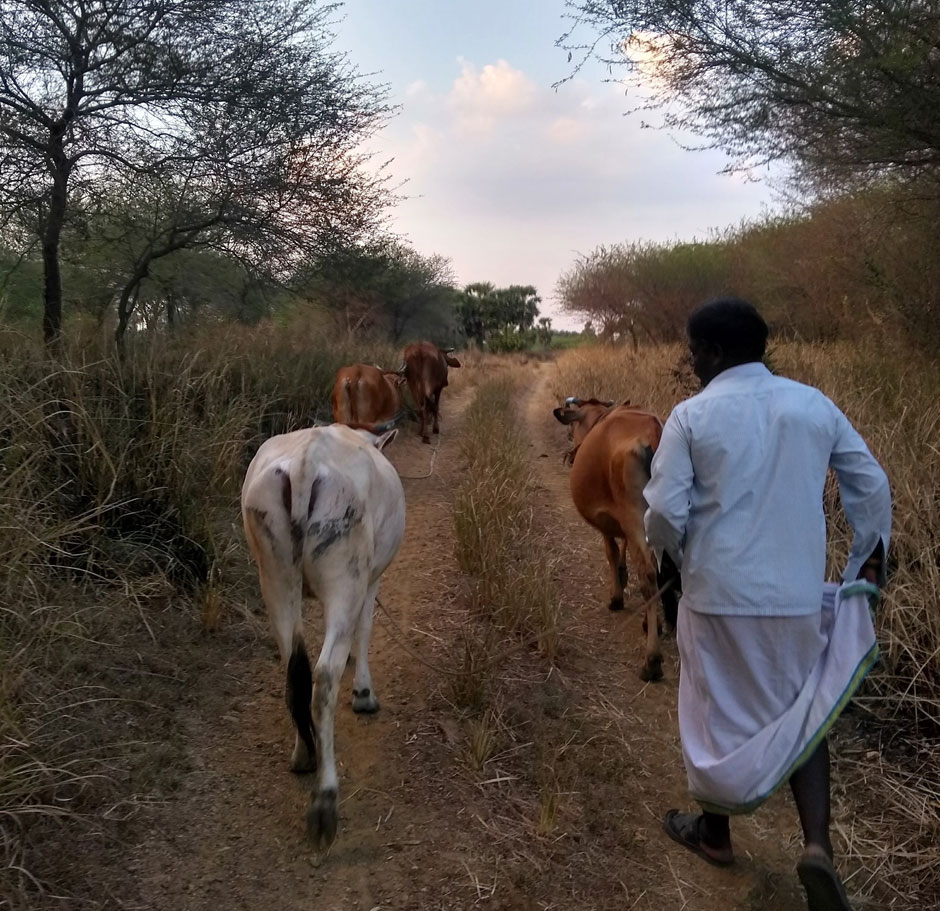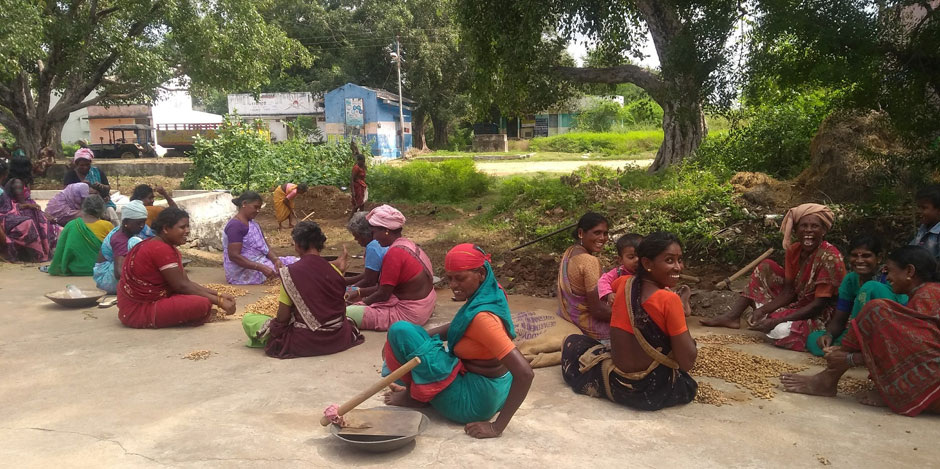by Divya Sharma and V. Gajendra, Relational Pathways project
In the Relational Pathways project we are trying to understand the pathways in and out of poverty for farmers in India and Kenya. ‘Green Revolutions’ are a prominent way of discussing how farmers can benefit from technology.
In Tamil Nadu, India, we have been using a technique called ‘life histories’ to explore how farmers experienced the decades of the Green Revolution.
We arrived in the drought-prone North Arcot region of northern Tamil Nadu at the same time as the northeast monsoon in late October. Monsoons here are expected to last till December. Following a severe drought in 2016, this monsoon season was particularly significant. But will the rain gods oblige?
It appears not. The rain gods have disappointed farmers yet again. After a few sporadic showers, trepidation about water availability, crop damage and unremunerative prices were palpable in our preliminary conversations with people.
The North Arcot region, now part of Tiruvannamalai and Vellore districts, has been an important rice production centre since the onset of the Green Revolution in the early 1970s. Dominated by smallholders this semi-arid area has a high density of wells and pump sets. Along with introduction of high-yielding rice varieties and synthetic chemical fertilisers and pesticides, groundwater extraction is a key factor in propelling increased productivity.
 Using Arani, a bustling town of about 70,000 people, as our base for a six-month fieldwork stint, we visit the two study villages a few kilometres south every day.
Using Arani, a bustling town of about 70,000 people, as our base for a six-month fieldwork stint, we visit the two study villages a few kilometres south every day.
As we leave town, the rice mills give way to a landscape dotted with palmyra and coconut trees, vast stretches of paddy fields interspersed with groundnut, and some patches of ragi (finger millet), sugarcane and banana plantations. Native species such as athi maram (fig trees) and eecha maram (date trees), which elderly people say were everywhere during their childhood, are a rare sight now. Significant tracts of fallow land are covered with thorny acacia locally known as veli maram.
Cows, goats and sheep can be seen grazing in fallow lands and in recently harvested fields with paddy residue. Several private education institutions and housing plots line the roads in the midst of farmland – real estate development through acquisition of dry agricultural land over the past three decades.
We aim to document detailed life histories of 24 men and women over the age of 50, who have lived through the Green Revolution decades. While our primary focus is on changes in livelihood trajectories and farming practices, the life histories are a collaborative endeavour with our research participants. Rather than sticking close to our pre-conceived focus areas, we are adopting an open-ended approach to incorporating ‘events and relations’ that are significant to our research participants’ specific understandings of well-being and poverty.
There are other ways in which we are contextualising the life histories in their own relational surroundings. An obvious context is provided by the villages. The first village is peri-urban, with approximately 1000 households. Apart from agriculture and silk saree weaving, men work in the Arani rice mills, temporarily migrate to Chennai or Bangalore for construction work, and even travel as far as Mumbai and Surat to work in the textile industry. Land under cultivation has been reducing, due to lack of water for irrigation and real estate development, which has meant a significant decline in the availability of agricultural work for landless households.
The second village is 18 kms away from Arani. It is predominantly agrarian, with about 160 households. Mostly landless Dalit men migrate for work while their families often stay in the village due to the prohibitive cost of living, particularly housing, in the cities.

Landholding caste households cultivate small parcels of land but are investing in and hoping for non-agrarian futures for their children. Dairy farming provides a meagre but stable income, in contrast to volatile and precarious agricultural incomes. The government’s employment guarantee scheme MGNREGA, supposed to assure 100 days of minimum wage work to one person in every household, is an important source of supplementary income.
Our research participants include small, marginal and medium landowning farmers, landless cultivators who farm leased land and agricultural wage workers. Many participants have moved in and out of these categories, and in and out of agriculture. Documenting life histories has allowed us to trace this movement, the conditions that propel such movement and most critically how people negotiate and experience such movement.
Many also traverse multiple roles simultaneously in the present: small farmers who cultivate one or two acres and also work for daily wages in others fields – spraying pesticides, ploughing using tractors or oxen; women from landowning households but with no land in their name, who do transplanting and weeding for wages; migrant workers who come back to the village to work on their farms during sowing and harvesting with their family members.
The life histories illuminate intersecting class, gender and caste identities, situated in people’s relational-temporal landscapes. The stories people tell about their lives, juxtaposed against the synchronic view of how they are perceived by others, paint a complex picture. The certainty of assertions in the present is also unsettled by the memories of the past, and vice versa.
In addition, the narratives people construct about their lives provide valuable insights into realised as well as unfulfilled aspirations. The shifts in livelihood trajectories, between agrarian and non-agrarian work, are shaped not only by economic stresses but reflect a struggle for dignity, status and autonomy. People’s narratives are a window into the decision-making process that goes into making these livelihood shifts, and expansive notions of well-being.
They also offer reflections on how systemic and policy developments have intersected with their everyday life to enable or constrain such shifts. People relate processes such as the introduction of hybrid rice, pump sets for irrigation, tractors, with corresponding changes in labour relations and livelihoods, the transformation of physical and institutional infrastructure, and movements along intersectional class, gendered and caste lines.

Our research participants are extremely generous with their time as we conduct multiple interviews, often as they go about their daily activities within the house or in the fields.
Our conversations with men are often in the fields when they are irrigating, looking after the sown crops, or taking the cows out for grazing. These ambulatory interviews have allowed us to understand the material landscape, viewed through their eyes. They have also allowed us to observe how they relate to and interact with crops, machinery, cattle and other non-humans in the field. Occasionally we accompany farmers on excursions to nearby towns for buying seeds, pesticides and fertiliser or to the regulated marketing committee for selling harvested crops.
With women participants, interviews generally take place in their homes, as they straddle household chores with work in the fields. We also talk to them as they work almost always in groups either transplanting or weeding on farms, or clearing water channels and planting trees as part of MGNREGA. As they perform physically strenuous labour, bent over knee deep in muddy paddy fields, or weeding and harvesting groundnuts in dryland, there is continuous joyful banter and sometimes intense bickering over the distribution and pace of work.
Sharing in this rich social and ecological landscape that constitutes and contextualises people’s life histories, as narrated by them, we hope to do justice to them in our articulations on the written page, in the near future.
Divya Sharma and V. Gajendran are researchers on the project Relational Pathways: Mapping Agency and Poverty Dynamics through Green Revolutions.

Very good initiative from MGNREGA. which really made the villagers to restore their life. Understand how modern farming can be done.
I’m from a village called “Saligram” near KR Nagar district. I’ve seen farmers struggling in summer because of no rains. That was the hardest time for the farmers to yield crops & sad situation to witness the struggle of the farmers!! 🙁